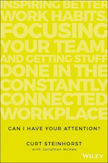Other Titles:
Healthy Hustle: Doing your best without burning out
Despite wellness programs, unlimited vacation days, and flexible arrangements, high-performing individuals are burning out at epidemic levels.
In 1930, economist John Maynard Keynes predicted that technology would allow us to work only 15 hours per week by the end of the century, leading to an increase in leisure time and standard of living.
Technology has enabled us to do more, faster, yet we find ourselves bored, miserable, overwhelmed, exhausted, and burnt out.
What Keynes didn't predict was that technology would open the floodgates to infinite connections, opportunities, ideas, tips, and ultimately, an overwhelming amount of information. And we consume 118 zettabytes of it daily. How we make decisions about what information deserves our attention will determine how we respond to this environment.
In this presentation, Curt Steinhorst emphasizes the power of human attention and focus to overcome stress and burnout. By combining brain science with the realities of working in today's connected world, Curt's "focus wisdom" helps individuals achieve a meaningful career and life.
The New Team Rules: How to collaborate with teams in a way that achieves clarity of purpose and higher (not broken) productivity
How do you build a productive team when co-workers are no longer in the same room or even available during the same hours?
And how do you create better rhythms of work and communication that ultimately drive greater engagement and success for your team?
Effective teams foster creativity, accountability, and diverse ideas, but achieving this is complex. Different work styles and priorities can lead to conflicts and slow progress. Communication overload and excessive meetings can reduce focus and productivity. Team dynamics can result in power struggles, lack of accountability, and stress.
In this session, Curt Steinhorst outlines hidden drivers that can harm teams. He provides a playbook for working together in a way that makes room for diverse work styles and communication preferences.





